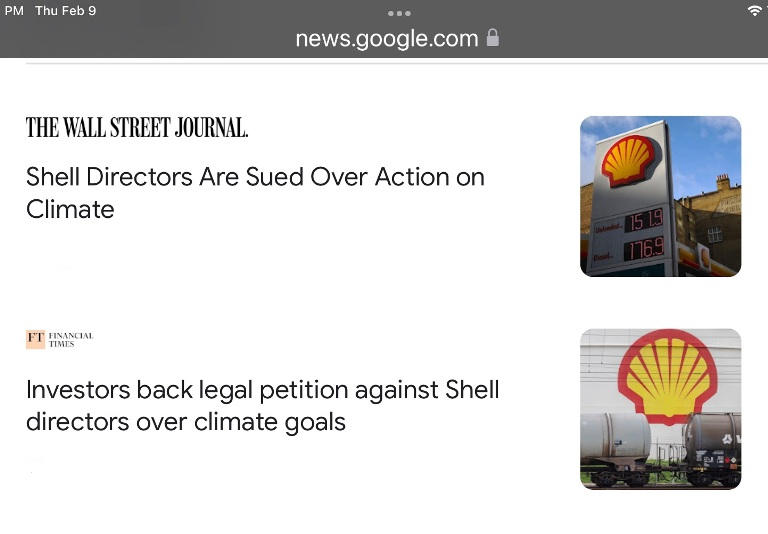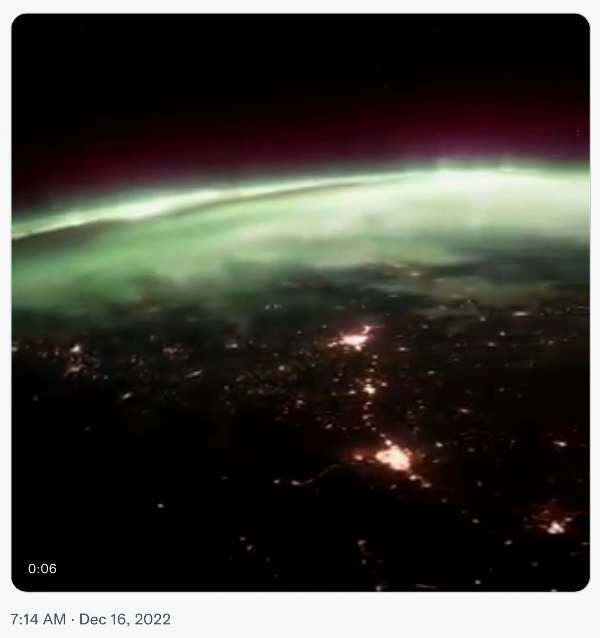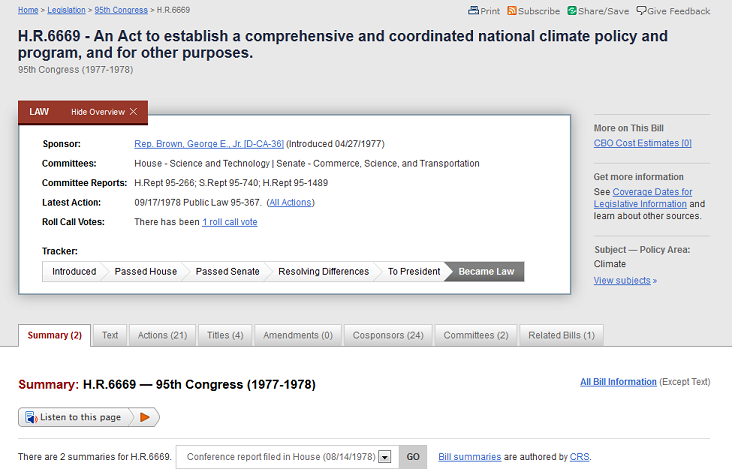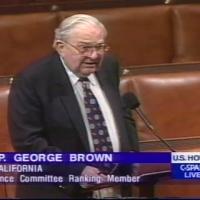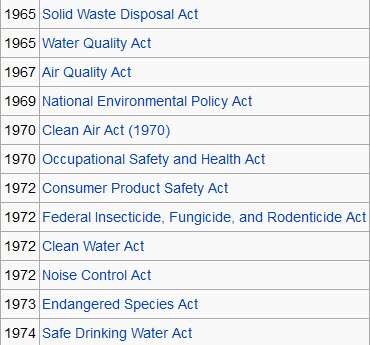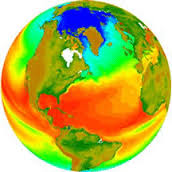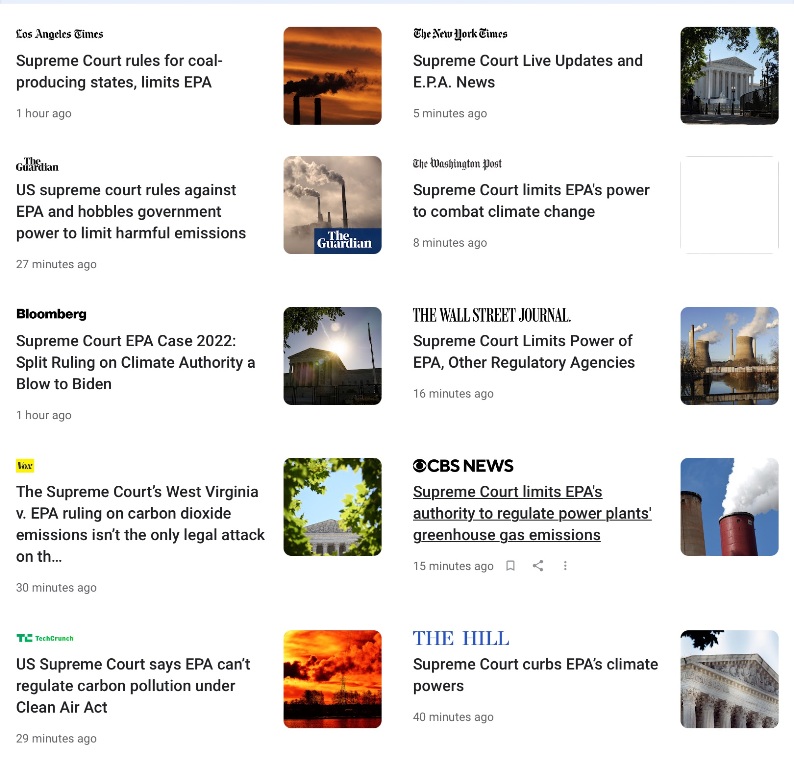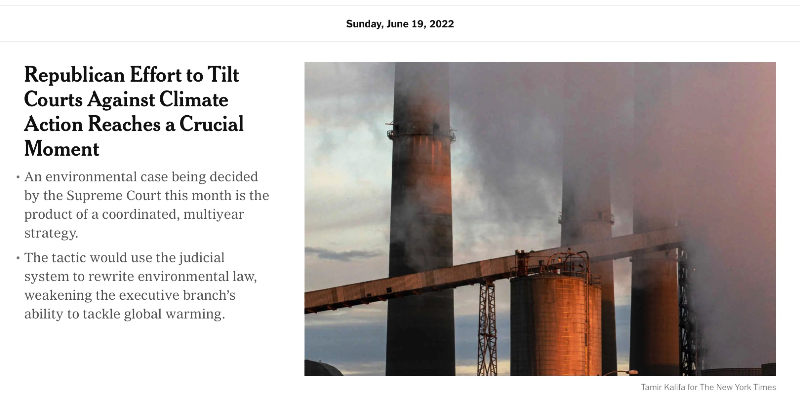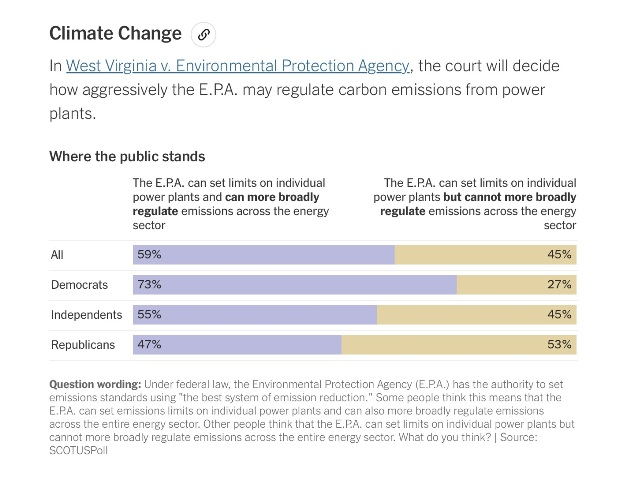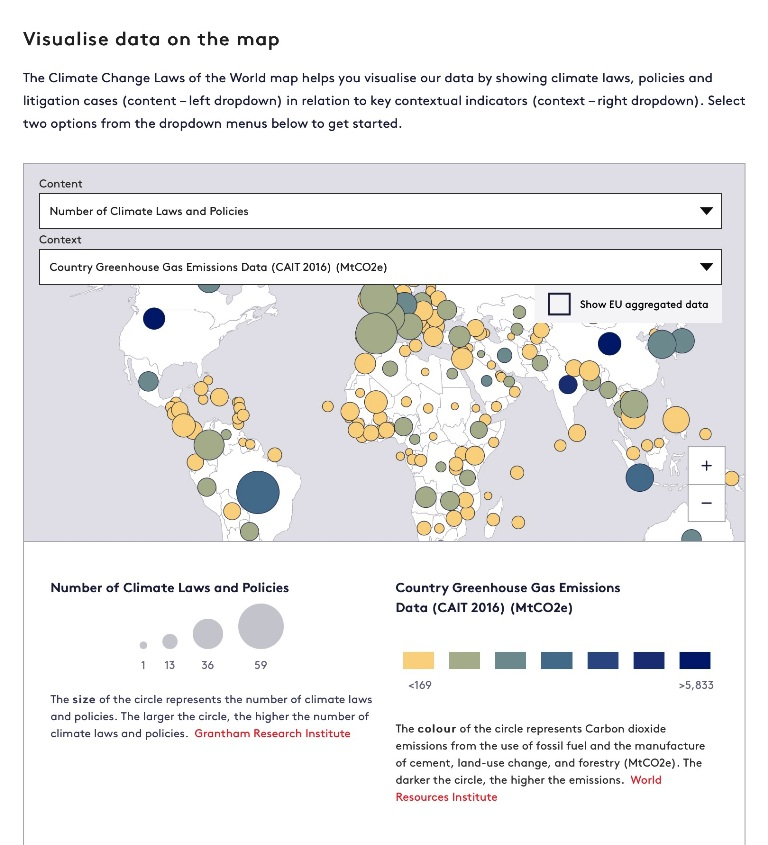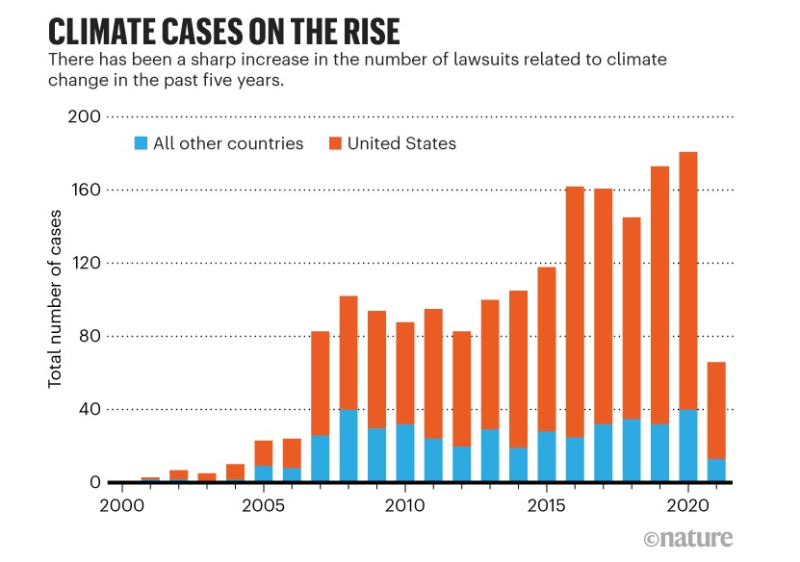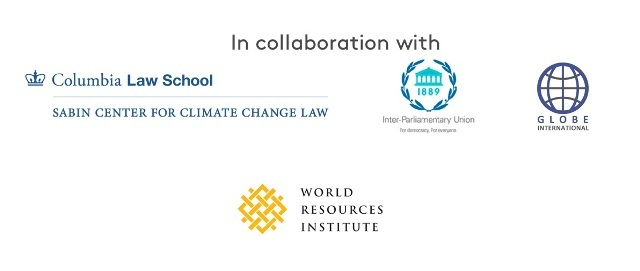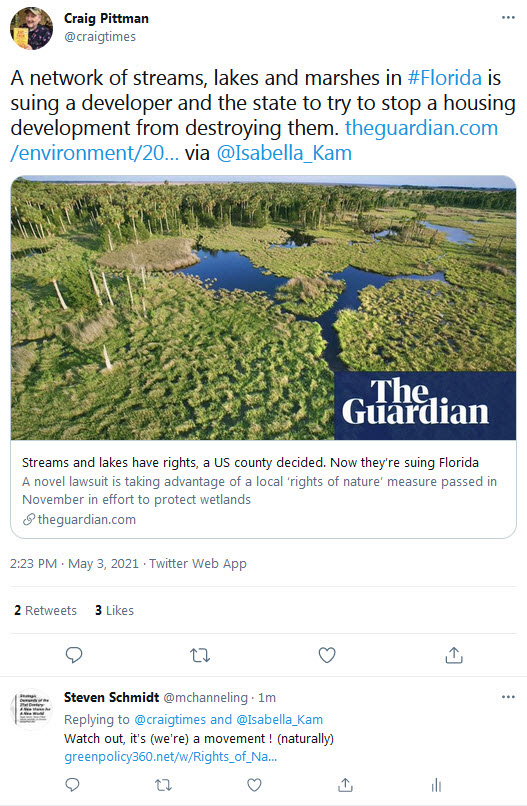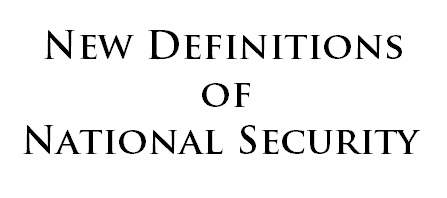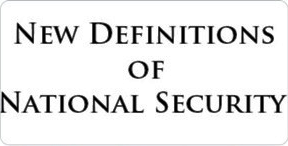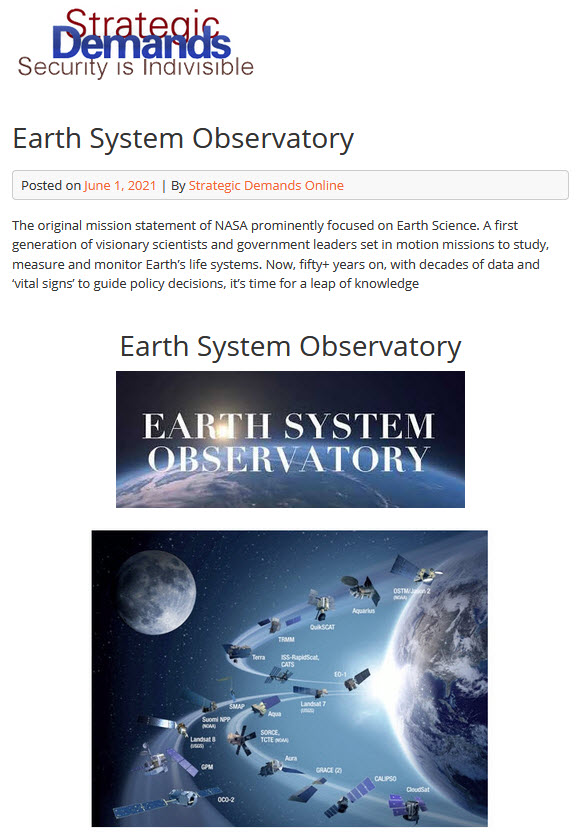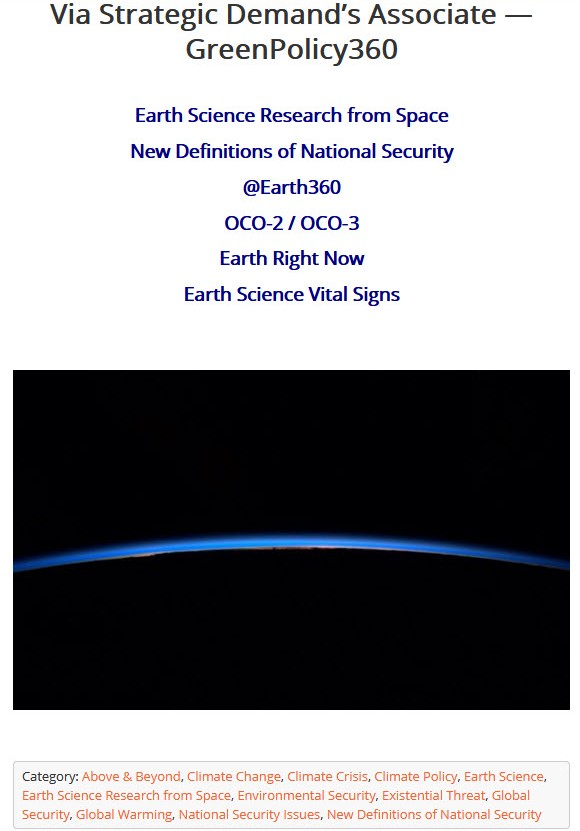Environmental Laws and Modern Environmental Movement
2024
Looking back and looking forward at environmental protection, as a movement, vision, ideas, laws...
A history we inherit and a legacy with rights, responsibilities, hope and action as we together go forward.
The lost history of what Americans knew about climate change in the 1960s
It wasn't just scientists who were worried, but Congress, the White House, and more...
GreenPolicy360: Naomi Oreskes, a historian of science at Harvard University, has a new study of the environmental movement's deep work on the causes of climate change. The history of Earth science, and U.S. legislative hearings, findings, and the federal records reveal legal underpinnings that now have greatly increased importance with U.S. Supreme Court decisions shaping (and limiting) the authority and powers of the EPA and other Executive agencies.
What was the Congressional intent behind the Clean Air Act of 1970. GreenPolicy360's siterunner heard one of the key members of Congress, Rep. George E. Brown, discuss this and climate, and related physics, science, health, economics, the pressing need for missions with NASA/NOAA/USGS and universities like CalTech with JPL, MIT, and on and on...
The trove of documentation Professor Oreskes is bringing to light is adding needed revelations to the beginnings of the modern environmental era.
The Planet Citizens, Planet Scientists, the activists, environmentalists, legislators, experts and educators were visionaries who saw a big picture and chose, purposely, to take steps to protect us all.
Here's to those who stepped up in the early days. They and their ideas, their key work and intent deserve to be remembered.
Via GRIST / August 2024
🌎
A GreenLaw360 site is now part of our GreenPolicy360 "National Climate Plans Initiative".
GreenLaw360.com
- GRN360 Climate Action
GreenPolicy360: Climate Plans Enforcement Initiative
- Methods to Enforce National Climate Plans, Pledges & Promises
GreenPolicy360 and Strategic Demands Put Forward 'New Definitions of National Security'
- As Planet Citizens, we continue decades of work to change how nations calculate security & to create 'new visions' of mutual security
* https://www.greenpolicy360.net/w/File:%27Thin_Blue_Layer%27_of_Earth%27s_Atmosphere_l.jpg
GreenPolicy360:
- Legally Enforcing National Climate Plans Must Be Our Priority
Here we go... On the following page, we attempt to give an overview and inside view of many elements and moments of the modern environmental movement.
GreenPolicy360 points to the critical importance of environmental, local/national/global security and the history, challenges and key accomplishments of the environmental movement.
As it was, our work was there at the beginnings and we welcome visitors to surf the story we tell here -- a who, what, where, when, why story -- a story that is up close and personal.
The story begins in the mid-1960s and has become over years a long thread with connected threads, a tapestry now. The story is told chronologically, with occasional vignettes, references, graphics and links, sidebars and flashbacks that take us up to the current time and events going on around us, with us, and to us.
So join in, look, consider, reflect, and act to make a difference.
With the 2024 U.S. presidential we are remembering the consequences of Trump 2016-2020
The Trump Administration Rolled Back More Than 100 Environmental Rules
- Here’s the Full List:
In all, a New York Times analysis, based on research from Harvard Law School, Columbia Law School and other sources, counts nearly 100 environmental rules officially reversed, revoked or otherwise rolled back under Mr. Trump. More than a dozen other potential rollbacks remained in progress by the end but were not finalized by the end of the administration’s term.
More @GreenPolicy360
- Brookings - Trump Deregulatory Tracker
- Brookings on Trump's Environmental Dereg. Record
- Climate Litigation Database
- Climate Deregulation Tracker
- Columbia Law School - Climate Change Blog
- Columbia Law - Energy Law
- Columbia Law - Environmental, Land Use Law
- Columbia Law - 'Silencing Science' Tracker
- Harvard Law - A List of Organizations Tracking US Environmental 2016-2020 Rollbacks
- NYT - Trump Envir Rollbacks
Tracking Biden Era Envir-Climate Laws
····························
2023
Precedent-setting state constitutional, environmental protection, climate law court decision
News from the Climate Action Frontlines, via Columbia Climate School, State of the Planet
Montana Young People Have Won a Key Climate Case, What That Means -- So Far
On August 14, a state judge issued a landmark ruling in favor of young Montana climate activists in the Held v. State of Montana case. The plaintiffs claimed that the state violated their right to a clean and healthful environment under Montana’s constitution. District Court judge Kathy Seeley declared that a state law violated this right by stopping agencies from considering climate impacts when conducting environmental reviews. This is the first constitutional climate trial in the United States, confronting a state’s responsibility for climate change.
Experts at the Sabin Center for Climate Change Law, an affiliate of the Columbia Climate School, have been following the case closely since its inception. The case summary and key documents can be viewed in the center’s climate change litigation database; edirector Michael Burger recently wrote a lay explanation of the case. This month, the center also issued a new report that explores trends and prospects in climate litigation around the world.
According to the report, the number of climate cases has more than doubled in the last five years, and litigation is expected to continually increase. The report says that as of the start of this year, there are 2,180 climate change cases underway around the world, with 1,522 in the United States alone. There are cases in 55 countries, with many in Britain, Europe, and Australia, along with a growing number in Asia and the Global South. Apart from the report, the director of global legal strategy at the Foundation for International Law for the Environment in the Netherlands said that about 50 percent of cases are being won.
“Litigation is a critical tool that’s available to a wide range of actors, including governments at all levels, nongovernmental organizations and community groups, individuals and the private sector to seek to advance climate action,” said Michael Burger, executive director of the Sabin Center for Climate Change.
Sabin Center Staff Weigh in on Held v. Montana Case
Below are links to extensive media coverage quoting Sabin Center experts on recent climate-related environmental law news. This list originally appeared on the Columbia Law Climate School website, and is updated regularly.
Columbia Law School / Columbia Climate School -- current climate/legal news and links:
Featured environmental law expert - Michael Gerrard, Sabin Center faculty director and professor of climate, Columbia Climate School
Montana Judge Rules in Favor of Climate Activists in Lawsuit Over Fossil Fuels, Meet the Press NOW, August 16, 2023 (Michael Gerrard's appearance at 00:45 minute mark)
Links to Media News and Op/Ed Coverage of Montana Court Decision Updated Here
A Court Win in Montana Could Help Climate Litigation Everywhere Else, Bloomberg, August 16, 2023
A Win for Young Environmentalists in Red State Montana, Background Briefing with Ian Masters, August 16, 2023
1 big thing: Climate law's elemental challenges, Axios, August 15, 2023 -- Michael Gerrard says that a handful of U.S. states (six states - Hawaii, Illinois, Massachusetts, Montana, Pennsylvania, and Rhode Island) have constitutional language guaranteeing a right to environmental protection.
- https://blogs.law.columbia.edu/climatechange/2021/08/31/environmental-rights-in-state-constitutions/
~
Montana judge hands young plaintiffs significant victory in landmark climate trial, CNN, August 15, 2023 “This Supreme Court has been more about taking away rights than granting new ones.”
Judge sides with youth activists in groundbreaking climate change lawsuit, Popular Science, August 15, 2023
Kids Win Huge Case on Climate in Montana Court with Climate Change Law Stand up! with Pete Dominick, August 15, 2023
Judge rules in favor of young activists in Montana climate change trial NPR, August 14, 2023
Court sides with kids who sued Montana over climate change, The Hill, August 14, 2023 “That’s what made the big difference here — the fact that this was brought under the environmental rights provision of the state’s constitution. That was the key to victory.”
Montana Youth Win Historic Case on Harm From Climate Change, Bloomberg Law, August 14, 2023 “I think this is the strongest decision on climate change ever issued by any court.”
What to Know About the Groundbreaking Climate Change Lawsuit in Montana, Mother Jones, June 26, 2023 “There have been hundreds of lawsuits but very few of them go to trial.”
Youth-Led Climate Change Trial in Montana Sets the Stage for More, The Messenger, June 20, 2023
Verdict awaited in historic US climate trial, Agence France-Presse, June 20, 2023
Dramatic week in Montana climate trial as youngsters tell of toll on lives, The Guardian, June 17, 2023
Group of 16 young people sue state for allegedly violating its own constitution: ‘The State may have to change its policies‘, The Cool Down, June 17, 2023
The Lawfare Podcast: Michael Gerrard on Held v. Montana, Lawfare Blog, June 16, 2023
16 young people are suing the state of Montana over the climate crisis – one resident says the wildfire smoke makes him want to lie in bed and cry, Insider, June 15, 2023 “We are so far behind where we need to be in reducing greenhouse-gas emissions that every lawful tactic needs to be pursued. And litigation is certainly one of them.”
Historic first US youth climate change trial starts in Montana, Nation of Change, June 15, 2023
In Montana, Youth File Historic First Lawsuit Related to Climate Change, GLOBE, June 14, 2023
In Court Testimony, Climate Scientists Rebuke Montana for Support of Fossil Fuels, Desmog, June 14, 2023
Landmark youth-led climate case heads to trial in Montana, Washington Post, June 12, 2023
Do children have a right to a healthy climate? Montana case is a test, Christian Science Monitor, June 12, 2023 “It will also be a moment where climate change scientists can make their case in court about the connection between climate change and extreme weather.”
Historic First U.S. Youth Climate Change Trial in Montana, EcoWatch, June 12, 2023
First Youth Trial On Climate Change Starts In Montana, One Green Planet, June 10, 2023
First U.S. youth climate change trial kicks off in Montana, Reuters, June 9, 2023 “A favorable decision could have a ripple effect around the world, inspiring new cases under multiple theories.”
In Montana, It’s Youth v. the State in a Landmark Climate Case, The New York Times, March 24, 2023
Judge Rules in Favor of Montana Youths in a Landmark Climate Case, The New York Times, August 14, 2023 “This was climate science on trial, and what the court has found as a matter of fact is that the science is right. Emissions contribute to climate change, climate harms are real, people can experience climate harms individually, and every ton of greenhouse gas emissions matters.”
Montana youth climate lawsuit exhibits an emerging front against polluters and stagnant politicians, Footprint Coalition, June 22, 2023
Landmark climate case heads to judge, The Hill, June 21, 2023 “The trial will be a major stage for the nation to see contemporary climate attribution science, which links climate change to both slow onset changes in the environment and more immediate, short-term, extreme events.”
The trial that marks a milestone in American youth’s fight for climate starts in Montana, Tech Codex, Jun 13, 2023
The Stand Science Will Assume, Bolly Inside, June 13, 2023
Landmark youth climate trial begins in US state of Montana, Agence France-Presse, June 13, 2023 “Governments and the fossil fuel industry “tend to say that… nothing should be done until everybody agrees to do everything, and that no individual contribution can be so big as to matter.”
Landmark ‘kids’ climate trial begins: how science will take the stand, Nature, June 12, 2023
Youth litigants say Montana is violating their right to healthy environment, KCRW, June 12, 2023
Western courts grapple with climate change, Grist, May 24, 2023 “It certainly is possible that the existence of a constitutional right will give an individual judge some greater comfort in making a bold decision.”
Montana Lawsuit Confronts States’ Responsibility for Climate Change, Brennan Center for Justice, op-ed by Michael Burger, May 22, 2023
Date set for first youth-led climate trial in U.S. history, NBC, February 7, 2022 “One way that people respond when other systems fail, when politics fail, governments fail, corporate governance fails is they go to court to try and seek redress.”
Additional Montana climate decision media mentions:
Why the Montana Climate Kids Can’t Lose, Heatmap, June 23, 2023
First U.S. Climate Trial Begins and is Led by Kids, Scientific American, June 9, 2023
Montana Youth Prepare for Trial in Major Climate Case against the State, Sierra Magazine, June 7, 2023
Visit the following page at Columbia Law/Climate School for current climate/legal news and links:
···············································
August 2023 / In the U.S. / A 'Game-changing Court Decision
Judge rules in favor of Montana youths in landmark climate decision
‘This is a monumental decision,’ said a lawyer for the young plaintiffs, and could influence how judges handle similar cases in other states
In the first ruling of its kind nationwide, a Montana state court decided Monday in favor of young people who alleged the state violated their right to a “clean and healthful environment” by promoting the use of fossil fuels...
The Held Decision
(HCR) The Montana court ruling is a major legal victory for those combating climate change:
In 1972, after a century of mining, ranching, and farming had taken a toll on Montana, voters in that state added to their constitution an amendment saying that “[t]he state and each person shall maintain and improve a clean and healthful environment in Montana for present and future generations,” and that the state legislature must make rules to prevent the degradation of the environment. In March 2020 the nonprofit public interest law firm Our Children’s Trust filed a lawsuit on behalf of sixteen young Montana residents, arguing that the state’s support for coal, oil, and gas violated their constitutional rights because it created the pollution fueling climate change, thus depriving them of their right to a healthy environment. They pointed to a Montana law forbidding the state and its agents from taking the impact of greenhouse gas emissions or climate change into consideration in their environmental reviews, as well as the state’s fossil fuel–based state energy policy.
That lawsuit is named Held v. Montana after the oldest plaintiff, Rikki Held, whose family’s 7,000-acre ranch was threatened by a dwindling water supply, and both the state and a number of officers of Montana. The state of Montana contested the lawsuit by denying that the burning of fossil fuels causes climate change—despite the scientific consensus that it does—and denied that Montana has experienced changing weather patterns. Through a spokesperson, the governor said: “We must focus on American innovation and ingenuity, not costly, expansive government mandates, to address our changing climate.”
Today, U.S. District Court Judge Kathy Seeley found for the young Montana residents, agreeing that they have “experienced past and ongoing injuries resulting from the State’s failure to consider [greenhouse gas emissions] and climate change, including injuries to their physical and mental health, homes and property, recreational, spiritual, and aesthetic interests, tribal and cultural traditions, economic security, and happiness.” She found that their “injuries will grow increasingly severe and irreversible without science-based actions to address climate change.”
The plaintiffs sought an acknowledgement of the relationship of fossil fuels to climate change and a declaration that the state’s support for fossil fuel industries is unconstitutional. Such a declaration would create a foundation for other lawsuits in other states...
Read the Decision:
August 14, 2023
RIKKI HELD, et al., Plaintiff, V. STATE OF MONTANA, et al., Defendant
- ······························································································
How can legislation – and especially precedent-setting and framework laws – support climate ambition?
- ······························································································
Grantham Research Institute’s 2023 Global Trends in Climate Change Litigation
- Annual series in its fifth year
- https://www.lse.ac.uk/granthaminstitute/events/global-trends-in-climate-litigation-2/
- https://climate-laws.org/faq
- https://www.lse.ac.uk/granthaminstitute/research-areas/climate-change-governance-legislation-and-litigation/
Multilateral Environmental Agreements (MEAs)
- International Environmental Law, Knowledge Database
- Negotiator's Toolkit, Resources for E-Action
- https://www.informea.org
- https://www.informea.org/en/node/493128
- https://www.informea.org/en/negotiators-toolkit
- https://www.informea.org/en/negotiators-toolkit/glossary
Regional and Global Environmental Treaties
Climate Change Laws of the World
- Climate Change Litigation Databases / Caselaw
- Climate Laws and Policies / Climate Litigation Cases / Countries / Mapped Data and Statistics
- https://climate-laws.org/
- https://libraryresources.unog.ch/climatechange/law
- https://www.ecolex.org/result/?q=&type=legislation&xkeywords=climate+change&xdate_min=&xdate_max=
- https://iclg.com/practice-areas/environment-and-climate-change-laws-and-regulations
- https://opil.ouplaw.com/display/10.1093/law-mpeipro/e3461.013.3461/law-mpeipro-e3461
- http://climatecasechart.com/
- http://climatecasechart.com/us-climate-change-litigation/
- https://www.lse.ac.uk/granthaminstitute/research-areas/
- https://www.lse.ac.uk/GranthamInstitute/legislation/
···············································
E.S.G. Fights Loom Ahead
Environment, Social and Governance: Value-based Investing to Deliver Sustainable, Positive Results
GreenPolicy360 -- Intelligent, appropriate, 'smart investing' beyond profits. Multi-stakeholder. Sustainable development. ESG investing is generation green.'
Kentucky's legislature targets banks and their climate policies. Bankers sue Kentucky's attorney general.
Green law and the fiduciary mainstream is where the action is...
○
Harvard Environmental & Energy Law Program
Environment, social, and governance (ESG) factors have boomed in recent years
Bloomberg projects that ESG investments may surpass $41 trillion worldwide by the end of 2022, up from $22.8 trillion in 2016. In the US alone, sustainable investments grew to $17.1 trillion in 2020, which accounts for a third of US assets under management according to the US Forum for Sustainable and Responsible Investment.
As interest in ESG investing grows, there is considerable variation in how fund managers define ESG and how funds approach ESG investing. For example, some funds may exclude certain polluting investments like oil and gas, while other funds may include some oil and gas companies based on their stated commitment to decarbonization. There is also variation in the utility of the ESG label to investors: researchers have found high levels of misleading claims among ESG funds.
Regulators and investors are questioning the approach and impact of many ESG funds. Given the lack of relevant reporting requirements, it’s difficult for investors to understand how a fund accounts for ESG factors in investment decisions and what impacts those investments have on the issues they claim to address.
○
Harvard Law School Forum on Corporate Governance
Long-Awaited ESG Rules
(Fact-finding) On May 25, 2022, in a long-awaited move, the U.S. Securities and Exchange Commission (“SEC”) issued a pair of rule proposals related to the use of environmental, social and governance (“ESG”) investment practices by open-end and closed-end registered investment companies, as well as by business development companies (“BDCs,” and collectively, “funds”). The SEC’s stated goals with these proposals are to increase transparency and confidence in funds that consider ESG factors as part of their investment process, given the recent and ongoing dramatic growth in investor interest in ESG investing. The SEC believes that investors looking to participate in ESG investing currently face a lack of consistent, comparable and reliable information among funds that claim to consider one or more ESG factors.
The first proposal seeks to create a robust disclosure and reporting framework for funds regarding their ESG investment practices. To effectuate this goal, the proposal would make a number of amendments to the registration and reporting forms utilized by funds in their securities offerings and ongoing periodic reporting. While the SEC does not generally prescribe specific disclosures for particular investment strategies, the SEC believes that ESG strategies and disclosures differ materially in certain respects that necessitate specific requirements and mandatory content standards to assist investors in making more informed investment decisions.
The second proposal would amend Rule 35d-1 (the so-called “Names Rule”) under the Investment Company Act of 1940, as amended (the “Investment Company Act”), to, among other things, add new requirements for funds that consider ESG factors in connection with their investment practices. The SEC believes that the Names Rule, which has not been amended since its adoption over 20 years ago, has not kept pace with industry developments and product evolution. Additionally, the SEC emphasized that competitive pressures may incentivize asset managers to include words in a fund’s name as a way to attract investor assets—for example, terms related to ESG. Further, the SEC expressed concern that the current Names Rule may permit funds to depart, over time, from the investment focus suggested by their name. Importantly, the proposed amendments to the Names Rule also would have significant implications for non-ESG funds, especially for those funds that may invest in more illiquid assets (including funds of private funds), and would mark a significant change, as the rule does not currently apply to commonly used fund names that focus on investment strategies instead of particular investments, such as “growth” or “income” funds.
Each proposal was approved by the SEC in a 3-1 vote along party lines, with Commissioner Peirce dissenting. The proposals will remain open for public comment for 60 days after their publication in the Federal Register.
○
ESG Factors
Environmental, social, and governance investing
Act Now with Business Intelligence
ESG Creates Value
Deloitte Insight into ESG
🌎
GreenPolicy360 and Strategic Demands:
New Definitions of National Security
🌎
Bookmark Climate Policy @GreenPolicy360
🌎
ClientEarth: We’re taking Shell's Board of Directors to court
This will be the first time ever that a company’s board has been challenged on its failure to properly prepare for the energy transition.
We’re going to court against Shell’s Board of Directors for failing to move away from fossil fuels fast enough.
This is the first ever case of its kind seeking to hold corporate directors personally liable.
February 9, 2023
- The reality of climate law enforcement approaches
🌎
International Environmental Law: A Body of Laws and Regulations in the Process of Development
- Environmental Laws @GreenPolicy360 -- https://www.greenpolicy360.net/w/Category:Environmental_Laws
Reaching All Nations to Go Green, Cooperate, and Act Now
Visit GreenPolicy360's "Climate Plans Enforcement" (Project-in-Dev 2021-2022)
- "Turning National Climate Pledges & Promises into Reality"
See GreenPolicy 2021 initiative for Legally Enforcing National Climate Plans
Visit GreenPolicy360's "Climate Plans Enforcement" (Project-in-Dev 2021-2022)
- "Turning National Climate Pledges & Promises into Reality"
🌎
Nations promise to protect 30 percent of planet to stem extinction
December 19, 2022
- Delegates at the COP15 biodiversity summit in Canada make major conservation commitment to try to halt loss of hundreds of thousands of plants and animals. Will nations follow through?
- GreenPolicy360: The question of questions is -- How will 'promises' by nations to protect life on Earth be enforced?
Today’s loss of biodiversity is being driven not by a space rock but by one species: humans. The loss of habitat, exploitation of species, climate change, pollution and destruction from invasive species moved by people between continents are all driving a decline in the variety of plants and animals...
Nations now have the next eight years to hit their targets for protecting life. With few legal mechanisms for enforcement, they will have to trust each other to protect habitats and funnel hundreds of billions of dollars over conservation.
“This is an incredible milestone for the world when it comes to conservation,” said Brian O’Donnell, the director of the conservation group Campaign for Nature. “We have been on a rapid path of destruction of nature for hundreds of years, and this can mark a turning point.”
The 10-year deal sets nearly two dozen targets. The banner commitment calls on nations to collectively conserve for wildlife at least 30 percent of land, inland waterways, and coastal and ocean areas by 2030 — the promise dubbed “30 by 30.”
“It’s a global goal. Every country commits what they are capable of committing,” said Masha Kalinina, a senior officer focused on biodiversity at the Pew Charitable Trusts. “Some will do more, some will do less.”
The world has a long way to go to achieving that goal. Right now, only about a sixth of the continents and a 12th of the oceans have some form of protection, according to the U.N.’s World Conservation Monitoring Centre.
🌎
August 2022
Democrats Designed the Climate Law (IRA) to Be Much More than First Meets the Eye
Via the NY Times | 08/22/2022
················································
Via E&E News | CLIMATEWIRE
08/24/2022
CO2 as a Pollutant
Climate legislation signed into law this month by President Joe Biden bolsters EPA’s ability to regulate greenhouse gases
In a first, climate law defines CO2 as air pollutant
In enacting a sweeping climate measure, analysts said Biden and congressional Democrats signaled a desire for EPA to tackle greenhouse gas emissions. Firming up EPA’s legal footing also is a boost for an agency that has faced court challenges from conservatives who question EPA’s authority to regulate greenhouse gases under the Clean Air Act. That authority rests on Massachusetts v. EPA, a 2007 Supreme Court decision that found the agency is required to regulate CO2 as a pollutant dangerous to public health.
····························
WEEKLY PLANET
08/24/2022 / Via The Atlantic
by Robinson Meyer
While it’s true that the IRA itself consists almost only of carrots, that is not true of the broader structure of American climate law. There is, in fact, a big “stick” for tackling carbon pollution already on the books in the United States, as well as an agency tasked with wielding that stick. I’m talking about the Clean Air Act and the EPA. And the IRA, by design, strengthens the government’s ability to wield that stick.
It does this in at least two ways. The first is that the IRA confirms that carbon dioxide is a type of air pollution covered by the Clean Air Act, as initially reported by The New York Times earlier this week.
This has broader consequences than it might seem. In 2007, the Supreme Court ruled in Massachusetts v. EPA that carbon dioxide counted as an air pollutant, and that, if the EPA decided that CO2 harmed human health and the environment, it could regulate CO2 under the Clean Air Act. That ruling—and the EPA’s official determination, a few years later, that CO2 is dangerous—has anchored the agency’s climate regulations on cars and trucks, and its proposed rules for the power grid.
But then in June, the Court circumscribed some of the EPA’s authority over the power grid. Conservative justices have harped on the fact that Congress has never clearly delegated the power to regulate greenhouse gases to the EPA.
Now it has. The IRA repeatedly defines greenhouse gas as a form of air pollution. It amends several sections of the Clean Air Act to define “greenhouse gas” as encompassing “the air pollutants carbon dioxide, hydrofluorocarbons, methane, nitrous oxide, perfluorocarbons, and sulfur hexafluoride.” In another section, it grants money under the Clean Air Act for any project that “reduces or avoids greenhouse gas emissions and other forms of air pollution.”
Congress has now clearly spoken: Carbon dioxide is a form of air pollution. And though this will not undo this year’s ruling, it buttresses the EPA’s underlying legal authority to regulate climate pollution.
············································································
The EPA Just Quietly Got Stronger
·················································································································
More on CO2 and Greenhouse Gases as Pollutants to be Regulated under Law
··················································································
Your GreenPolicy360 Founder/Siterunner's thoughts:
To the Supreme Court: Here is the exacting and specific language about CO2 and air 'pollutants'
Over the years, and on our GreenPolicy360 site, I have shared my knowledge of the formation of the Environmental Protection Agency, the Clean Air Act, the first era of environmental protection legislation and the first National Climate Act.
My long time friend Congressman George E Brown, a principal drafter of enabling legislation during the 1970s/80s/90s, and activist member and a chair of the House of Representative oversight committee of science, technology, and earth science/atmospheric science space programs, was a mover and shaker who shared with me many of his thoughts and initiatives.
Over the years, until his passing in 1999, I learned about the legislation and *the intent* of the legislation that he and his colleagues were drafting. His/their language, for example, the definitions of pollutants, was intended to be broad and expansive. The definition of air pollution in the Clean Air Act, for example, addressed health and safety, and protection of life ...
They knew that the science of the day would become more empirically defined as atmospheric and earth science they were setting in motion w NASA/NOAA and USGS missions was supported, funded, launched and reported. The empirical data, as they planned, was collected and analyzed over the years and decades and the scientific case became clearer and clearer. CO2 and other greenhouse gases were impacting air quality and atmospheric disruption was forcing climate change. The U.S. Supreme Court, unfortunately for years, was unable to accept the intent and language of the legislators on this critically important work. Recently, with the Massachusetts v. EPA 2007 Supreme Court decision and now with the signing of clarifying 2022 legislative language, the climate action work will gather scope and speed at the federal agencies, especially at the EPA.
When Congressman Brown drafted originating legislation establishing a national climate change research program via the National Climate Program Act of 1978, the scientific community and nation were just beginning to awaken to a new national security threat. I remember his concern, our concern. He was trained as a scientist, an engineer, with an ability to see facts and data sets in a way others could not.
Representative Brown was out in front of "Big Science". In his decades on the House Science, Space & Technology Committee, he worked to expand the reach of science. He knew that good data enabled good policy decisions. He pressed for first-generation earth science satellites and ongoing earth monitoring missions and data sharing.
Among his many initiatives, George Brown was a key figure in proposing, establishing, and then saving the Landsat program and its unique 'open-access' database of Earth Science imaging when President Reagan attempted to shut Landsat down. Landsat was a model for all the following earth science research missions from space and is now moving into its fifth decade with Landsat 9.
GreenPolicy360 Siterunner:
So I turn on the TV and the House science committee is in the Rayburn Bldg, and my memories return of hearing Room 2318. Twenty years after the passing of the Congressman who was often called "Big Science", there's George's official portrait on the science committee wall looking out at the latest and his generational legacy.
* https://www.greenpolicy360.net/w/File:George_E._Brown_official_portrait.jpg
"The Rayburn" is where the programs he proposed and shepherded into existence as a science committee chair and senior member for three decades were discussed, debated, and decided. It was democracy in action at its best. The now historic, ongoing programs he envisioned and set in motion included (hold on, this is a long list) -- the Science and technology office advising the president; the Environmental Protection Agency (EPA), yes the history of the EPA's formation is a story in itself; the Landsat program, the longest-running Earth Science study from space and and a constellation of Earth Science research missions from space, each advancing data, measuring and monitoring Earth systems, and all producing results that enable 'navigation', advising, guiding and available for planet citizens, planet scientists and current policy decision-making.
This week's House science hearing was on the consequences of global warming -- wildfires and how to measure them, track them, prevent them, intervene .... it almost brought tears to my eyes. Next to no one knows his name, but I do.... tip of the green hat to George
Read more about George Brown --
* https://www.greenpolicy360.net/w/George_E._Brown_Jr
Rep. George E. Brown, an activist member and for many years chair of the House Committee on Science, Space, and Technology
At the beginning of the 'space race', the House Committee on Science and Aeronautics was created by the 85th Congress in 1957 to oversee the newly-created National Aeronautics and Space Administration (NASA). The Science and Aeronautics Committee was the first committee since 1892 to be established for an entirely new area of jurisdiction. The committee’s jurisdiction over the years has expanded to include most civilian non-medical scientific research throughout the government, including National space policy, Earth remote sensing policy; Space commercialization, including commercial space activities relating to the Department of Transportation and the Department of Commerce, the National Science Foundation, the Energy Department, the National Institute of Standards and Technology (NIST), EPA, NOAA and the Department of Homeland Security. (Informally known as the Science committee, the committee's name was change to the "Committee on Science and Technology" in 1974. At that time, the Committee’s jurisdiction was expanded to include legislation related to energy, the environment, the atmosphere, civil aviation research and development, and the National Weather Service. The Committee on Science and Technology was also given a "special oversight" function providing for exclusive responsibility among all Congressional Standing Committees to review and study, on a continuing basis, all laws, programs and government activities involving Federal non-military research and development. In its early years, the Committee was an important partner in the Apollo Program that led to a man landing on the moon and strengthening science education and scientific research. After the Committee’s role expanded, the Committee has played an important role in much of the legislation Congress has considered dealing with domestic and international science, technology, standards, and competitiveness. In the 112th Congress, Chairman Hall changed the Committee's name to the "Committee on Science, Space and Technology."
Via Wikipedia / https://en.wikipedia.org/wiki/George_Brown_Jr.
Brown was known as a champion for science. He left behind a deep and expansive legacy that has shaped science and science policy in America. Among some of his many accomplishments during his service on the House Science Committee:
• Established the first federal climate change research program in the Federal Climate Program Act of 1978
• Established the Office of Science and Technology Policy
• Established the Environmental Protection Agency
• Established the Office of Technology Assessment
• https://www.greenpolicy360.net/w/Ethics_and_Climate_Change
• @GreenPolicy360, 'The beginning of the modern environmental era'
🌎
June 2022
File:SCOTUS News re West Virginia v EPA Decision.pdf
West Virginia v EPA
Click Here for a scan of news/commentary and opinion re the June 30, 2022 decision
* https://www.greenpolicy360.net/mw/images/SCOTUS_News_re_West_Virginia_v_EPA_Decision.pdf
- * https://www.greenpolicy360.net/w/File:WV_v_EPA_SCOTUS_poll_-_June_27_2022_before_court_decision.png
🌎
GreenPolicy360 Siterunner:
Witness to an Environmental Movement, 1960s to the 2020s, a Generational Challenge
First came discovery, purposefully gathering the facts and data of environmental disruption, earth and atmospheric science, biodiversity and loss of habitat, loss of life, global warming and climate change;
Followed by decades of green activism making the case for environmental protection/environmental security, advancing new definitions of national and global security using the data now attesting to the scope of the problem, the immediacy of the threat, and challenge of overcoming deniers, naysayers and obstructionists;
Now we can see clearly, from the first international environmental protection gathering and resulting plan, the Stockholm Declaration of 1972 until today, with some 200 individual national (intended and determined) climate/environmental plans put forward after the Paris (2015) and Glasgow international summits (2021), that the clock is running behind. The times call for "Climate Plans Enforcement".
Climate Plans Enforcement - Resources
From Then until Now... and What Happens Next
In the early years of the modern environmental movement, a conscious effort was made to construct a foundation of environmental laws and regulations on which a multi-year environmental protection framework could be built. Your GreenPolicy360 founder was one of those who believed in this constructive paradigm, using model legislation that could be locally developed, often in our state of California, then shared, 'exported' as we used to say, 'to the Feds' for adoption at the national level. The history here provides an ongoing modus operandi from the 60s and 70s until now as we deal with the pressing local, national, and international/global environmental threats and crises. We, at GreenPolicy360, call this "green best practices". Best practices is a model for sharing, networking, building on success and action. Templates and models, best practices made openly available, are our plans for having multiplier effects -- and it is our ongoing mission. A strong and resilient legal foundation and framework of environmental laws is an essential part of our overall work. We encourage you to join in as citizens of every nation, within your multiple and diverse legal systems and, we must add, as planet citizens. It is time for concerted planet citizen action.
🌎
Climate Change
Climate Change Laws & Lawsuits
* https://www.greenpolicy360.net/w/File:Climate_Change_Litigation_Databases_Climate_Law.png
🌎
Climate-Related Laws/Statutes, Ordinances, Regulations, Rules | Law Making & Rules Making
🌎
Global Stats|Trends in Climate Change Litigation
Reported via Wikipedia / MediaWiki collaboration
🌎
Climate Change Laws of the World
Climate Change Laws via Grantham Institute, UK (Current)
- Search the full text of over 5000 laws, policies and UNFCCC submissions from every country
About ClimateLaws.org
Climate Change Laws of the World and Climate Change Litigation of the World build on more than a decade of data collection by the Grantham Research Institute at LSE and the Sabin Center at Columbia Law School.'
Climate Change Laws of the World covers national-level climate change legislation and policies globally. The database covers climate and climate-related laws, as well as laws and policies promoting low carbon transitions, which reflects the relevance of climate policy in areas including energy, transport, land use, and climate resilience.
Climate Change Litigation of the World features climate litigation cases from over 40 countries. These cases raise issues of law or fact regarding the science of climate change and/or climate change mitigation and adaptation policies or efforts before an administrative, judicial or other investigatory body. This dataset does not include the United States – to access information about climate change litigation in the US, please click here to go to the Sabin Center / Arnold & Porter Kaye Scholer database. This will take you to a different website and will open in a new window.
This database originates from a collaboration between the Grantham Research Institute and GLOBE International on a series of Climate Legislation Studies. Use and reference of the data.
The Grantham Institute encourages the use of this database. Users are welcome to download, save, or distribute the results electronically or in any other format, without written permission of the authors.
For data drawn directly from the Grantham and/or Columbia database, reference the source as follows: Climate Change Laws of the World database, Grantham Research Institute on Climate Change and the Environment and Columbia Law/Sabin Center for Climate Change Law.
Via Grantham Research Institute on Climate Change and the Environment
Key messages about climate change litigation (as of 2021)
• Climate change litigation continues to grow in importance as a way of either advancing or delaying effective action on climate change.
• Globally, the cumulative number of climate change-related cases has more than doubled since 2015. Just over 800 cases were filed between 1986 and 2014, while over 1,000 cases have been brought in the last six years.
• The number of ‘strategic’ cases is dramatically on the rise. These are cases that aim to bring about some broader societal shift.
• Not all strategic litigation is aligned with climate goals. However, not all strategic cases that are not aligned with climate goals are motivated by an intention to prevent climate action.
• Litigation that is aligned with climate goals is on balance seeing success and there has been a run of important wins in the last 12 months, such as the Milieudefensie v. Shell case.
• The number of cases challenging government inaction or lack of ambition in climate goals and commitments continues to grow, with 37 ‘systemic mitigation’ cases identified around the world.
• Cases are targeting a wider variety of private sector and financial actors and there is more diversity in the arguments being used, for example incorporating themes of greenwashing and fiduciary duty. Businesses need to be aware of litigation risk.
• Three areas to watch in the future are value chain litigation, cases of government support to the fossil fuel industry (e.g. through subsidies or tax relief), and cases focused on the distribution of the burdens associated with action, which may be classed as ‘just transition’ cases.
🌎
Columbia University / Climate Lawsuit Tracking
Climate Change Litigation Databases
Global Climate Change Litigation database
U.S. Climate Change Litigation database
Climate Law Blog / Columbia Law School
About Columbia's U.S. and Global Climate Change database (2022)
The U.S. Climate Change Litigation database is a joint project of the Sabin Center for Climate Change Law at Columbia Law School and Arnold & Porter. Michael B. Gerrard, then a partner at Arnold & Porter and now Faculty Director of the Sabin Center, and J. Cullen Howe, an environmental law specialist at Arnold & Porter, first created the U.S. Climate Litigation Chart in 2007. In 2017, it was relaunched as an interactive and searchable database. The U.S. chart is updated on a monthly basis, and currently includes 1404 cases* with links to 8925 case documents.
The Global Climate Change Litigation database was created in 2011 and is updated regularly. It currently includes 560 cases, with links to 1066 case documents. At present, the Global database features cases from over 40 countries. The database also includes climate litigation cases brought before international or regional courts or tribunals.
Examples of Case Categories
SUITS AGAINST GOVERNMENTS
- Access to Information
- Environmental Assessment and Permitting
- Failure to Adapt
- GHG Emissions Reduction and Trading
- Human Rights
- Just Transition
- Protecting Biodiversity and Ecosystems
- Public Assembly
- Public Trust
- Trade and Investment
Browse Litigation by Country - Jurisdiction
- Argentina
- Australia
- Austria
- Belgium
- Brazil
- Canada
- Chile
- Colombia
- Czech Republic
- Denmark
- Ecuador
- Estonia
- France
- Germany
- Guyana
- India
- Indonesia
- Ireland
- Italy
- Japan
- Kenya
- Luxembourg
- Mexico
- Nepal
- Netherlands
- New Zealand
- Nigeria
- Norway
- Pakistan
- Papua New Guinea
- Peru
- Philippines
- Poland
- Slovenia
- South Africa
- South Korea
- Spain
- Sweden
- Switzerland
- Taiwan
- Uganda
- Ukraine
- United Kingdom
Additional Government Organizations-Related Climate Change Litigation
- East African Court of Justice
- European Committee on Social Rights
- European Court of Human Rights
- European Union
- Inter-American System of Human Rights
- International Centre for Settlement of Investment Disputes
- International Courts & Tribunals
- Permanent Court of Arbitration
- Stockholm Chamber of Commerce
- United Nations
- World Trade Organization
🌎
Via Carbon Brief (2017)
Climate Change Laws Around the World
There has been a 20-fold increase in the number of global climate change laws since 1997, according to the most comprehensive database of relevant policy and legislation.
The database, produced by the Grantham Research Institute on Climate Change and the Environment and the Sabin Center on Climate Change Law, includes more than 1,200 relevant policies across 164 countries, which account for 95% of global greenhouse gas emissions.
The database shows the extent to which climate change legislation has permeated global political discourse, as well as variations in approach between developed and developing countries. You can explore the database via their interactive map...
As well as the database listing individual laws and policies, there are also narratives for each of the 164 countries covered (you can navigate to these country profiles).
Visit https://climate-laws.org/
🌎
Environmental Law
Environmental Rule of Law: First Global Report - UN / UN Environment Programms (2019)
"Weak enforcement ... a global trend"
The Difficulties of Enforcing Global Environmental Law via Georgetown Law Review
🌎
Environmental Law - an Overview via the Duke Law School
Guide providing an overview of federal, North Carolina-specific, and international environmental law sources. For additional sources, including different state materials, researchers may wish to consult other relevant research guides and portals such as Vermont Law School's Environmental Law Research Resources, and/or the Environmental Law guide prepared by Lewis & Clark Law School's Paul L. Boley Law Library
🌎
Environmental Law - Abridged Overview via the Yale Law School
🌎
International Environmental Law via the American Bar Association
Profound environmental changes caused by the increasing scale of human activity have led many observers to conclude that the planet has entered the “Anthropocene”—a geologic era signified by human impact on the biosphere. International environmental law is the set of agreements and principles that reflect the world's collective effort to manage our transition to the Anthropocene by resolving our most serious environmental problems, including climate change, ozone depletion and mass extinction of wildlife. More generally, international environmental law aims to achieve sustainable development—i.e., development that allows people to have a high quality of life today without sacrificing the quality of life of future generations. International environmental law is thus critical both for addressing specific environmental threats and for integrating long-term environmental protection into the global economy...
🌎
GlobalEnvironmentalLaw.com
The Global Environmental Law website was maintained by Prof. Robert Percival of the University of Maryland Carey School of Law.
The Global Environmental Law introduction to the online site captures the importance of sharing environmental laws -- 'transplanting law and regulatory policy innovations'.
"Globalization is transforming law and legal education. Nowhere is this more evident than in the field of environmental law. Environmental problems are viewed increasingly as transcending national borders and some—including global warming and climate change—pose significant risks to the very health of the planet. As a result, law has become a critical part in the efforts to combat global environmental problems and improve global living conditions."
"Legal systems across the globe are responding to environmental concerns in surprising new ways. Throughout the world, nations are upgrading their environmental standards. As they do so, they are frequently transplanting law and regulatory policy innovations derived from the experience of other countries, including nations with very different legal and cultural traditions."
- https://globalenvironmentallaw.com/blog/ (suspended posting in 2020)
🌎
Global Environmental Law via Cambridge University (October 2019)
Global Environmental Law: Context and Theory, Challenge and Promise
🌎
World Commission on Environmental Law
- IUCN Global Environmental Law Network
IUCN (International Union for the Conservation of Nature) Academy of Environmental Law
The Academy is a consortium of educators from 214 academic institutions in 60 countries dedicated to improving the teaching, development and implementation of environmental law…
🌎
Center for International Environmental Law
··································
GreenLaw360
In the U.S.
2021
In Florida, expanding Environmental Law with a Rights of Nature lawsuit...
🌎
Climate News
Time to act to make a positive difference
Strategic Demands
- https://unfccc.int/process-and-meetings/the-paris-agreement/nationally-determined-contributions-ndcs/nationally-determined-contributions-ndcs
- https://www.wri.org/ndcs/tracking-progress
- https://www.climatewatchdata.org/2020-ndc-tracker
- https://climateactiontracker.org/
- https://carbon-pulse.com/ndcs/
🌎
2020
With the election of Joe Biden, the environmental legal landscape emerges from an historic four years of environmental laws and rules rollbacks under the Trump presidency...
Environmental Laws, Regulations and Executive Actions
Tracking 2016-2020 U.S. Climate Actions under the Trump Presidency
Environmental Models -- Laws/Rules/Regulations/Templates and Practices -- for the World Is Setback during Crucial Years
- A List of Organizations Tracking US Environmental 2016-2020 Rollbacks
- Brookings - Deregulatory Tracker
- Brookings on Trump's Environmental Dereg. Record
- Climate Deregulation Tracker
- Columbia Law School - Climate Change Laws
- Columbia Law - 'Silencing Science' Tracker
- GreenPolicy360 - Environmental Laws
- GreenPolicy360 Climate Litigation Database
- Harvard Law - Trump Envir Law Rollbacks
- NYT - Trump Envir Rollbacks
Environmental Turnaround in the U.S.: Rebound with Caveats
- https://www.washingtonpost.com/graphics/2021/climate-environment/biden-climate-environment-actions/ | 2021 - Tracking Biden Climate Actions
~
An Unprecedented Presidency: The Trump Administration Damage to Democracy, Damage to the Environment
Historic Environmental Protection Cuts
Retreat from Treaties, Environmental Agreements, and Abandonment of International Cooperation on Climate
Decades of US Green Progress Attacked
Collapse of Environmental Laws and Policy Framework
List of Organizations Tracking Trump Administration Environmental Protection Rollbacks
Read about the Trump Environmental Rollbacks
Decades of environmental protection devastated. Polluters celebrate. Oil/gas pushes CO2 with fracking technology. US government climate action collapses.
Law & Environment, Protection & Retreat
The Future of International Environmental Governance
Experts have highlighted a clear legal challenge: international environment law is fragmented in many conventions and international declarations...
The Global Pact for the Environment will be the first international legally binding document, gathering and harmonizing all environmental laws in one single document. Its objective is to be an essential tool for governments to help them implementing environmental rules and principles in their own country.
- New Vision for a Connected World
- National & Global Security, Indivisible
New Definitions of National Security @GreenPolicy360
Environmental Security & "Thin Blue"
New Definitions of National Security @StrategicDemands
·······································································
Environmental Law / United States
Trump administration rushes forwRd with its anti-environmental law and dismantling of community health, protection and planning'
2020 witnesses a presidential administration attemptint to dismantle 50 years of environmental protection laws
(CNN) Here's a list of many of the major environmental rollbacks the Trump administration has attempted to undertake.
Oil, natural gas, methane and power;Automobiles; Public lands; Water; Wildlife; Agriculture...
Read about the U.S. U-turn...
- ·····················································
Earth Science, Advances and Setbacks
The 2016 U.S. election was a 'turn-back-the-clock' election result. Environmental laws passed with success over decades are being dismissed under Trump attack and a short-sighted, 'short-termism'. Pushing an agenda that deconstructs achievements of a previous generation, a U.S. President is leaving a damaging legacy. Every week seems to bring the announcement of another set-back to a green, environmental platform.
We should consider again the beginning of the green era in the U.S. and successive accomplishments in law and practice that clearly deserve to be built upon, not to be dismantled by retro-policies.
95 Environmental Rules Being Rolled Back Under Trump
US Environmental Laws Rollback Tracker
One Environmental Law Rollback
"This will be the biggest loss of clean water protection the country has ever seen," said Blan Holman, an attorney with the Southern Environmental Law Center.
The new measure will roll back Obama-era "Waters of the United States" (WOTUS) regulations aimed at ensuring wetlands and streams are protected under the 1972 Clean Water Act, which the Trump Environmental Protection Agency has repeatedly targeted.
"This puts drinking water for millions of Americans at risk of contamination from unregulated pollution," said Holman. "This is not just undoing the Obama rule. This is stripping away protections that were put in place in the '70s and '80s that Americans have relied on for their health."
As the New York Times reported in January 2020, the Trump rule "will remove federal protections from more than half the nation's wetlands, and hundreds of thousands of small waterways."
"His administration had completed the first step of [the WOTUS regulation's] demise in September with the rule's repeal," the Times reported. "His replacement will complete the process, not only rolling back 2015 rules that guaranteed protections under the 1972 Clean Water Act to certain wetlands and streams that run intermittently or run temporarily underground, but also relieves landowners of the need to seek permits that the Environmental Protection Agency had considered on a case-by-case basis before the Obama rule."
Trump and EPA chief Andrew Wheeler, a former coal lobbyist, touted the rule at the American Farm Bureau Federation's annual convention in Texas.
🌎
US acts to unravel environmental protections as president is impeached and another war is imminent
Trump administration attacks the 'Magna Carta' of US Environmental Protection, the NEPA Act
Update: April 19, 2022, shortly before the annual April 22nd Earth Day
The Biden administration acts to reinstate and enhance NEPA.
Reversal of a Rejection -- the Trump administration's rejection of NEPA environmental law, regulations/rules is addressed with executive orders.
Via the NY Times / NEPA is back ... Biden Restores Climate to Environmental Law, Reversing Trump -- https://www.nytimes.com/2022/04/19/climate/biden-climate-nepa-trump.html -- "Biden Restores Climate to Landmark Environmental Law, Reversing Trump" ...
The Biden administration announced Tuesday that it is restoring parts of a bedrock environmental law, once again requiring that climate impacts be considered and local communities have input before federal agencies approve highways, pipelines and other major projects.
The administration has resurrected requirements of the 50-year-old National Environmental Policy Act that had been removed by President Donald J. Trump, who complained that they slowed down the development of mines, road expansions and similar projects.
The final rule announced Tuesday would require federal agencies to conduct an analysis of the greenhouse gases that could be emitted over the lifetime of a proposed project, as well as how climate change might affect new highways, bridges and other infrastructure, according to the White House Council on Environmental Quality. The rule, which takes effect in 30 days, would also ensure agencies give communities directly affected by projects a greater role in the approval process.
Brenda Mallory, chairwoman of the council, described the regulation as restoring “basic community safeguards” that the Trump administration had eliminated.
“Patching these holes in the environmental review process will help projects get built faster, be more resilient, and provide greater benefits to people who live nearby,” she said in a statement.
·······································································
The foundation and platform of modern-era environmentnal policy:
National Environmental Policy Act
NEPA is often said to be the Magna Carta of the environmental movement...
National Environmental Policy Act, NEPA
○
Local Clean Water News / Politics
Fox News US ridicules local efforts to cut back on single-use plastic un-recycled household items
As US Clean Water Act Is Undercut by Fox-supported US president, a first study of 'Tampa Bay Plastic Pollution' reveals '4 Billion Microplastic Particles'
·············································
Looking Back, Looking Forward
The modern environmental movement: Environmental protection to build on
Environmental Protection, a First-Generation of Builders of an Environmental Legacy
Rep. George E. Brown and the generation who envisioned and worked with historic results to create a first phase of auto emissions, clean air standards and foundational state and national environmental standards...
Memories on the Road to the First Earth Day
• https://www.greenpolicy360.net/w/Earth_Day_Memories_on_the_50th_Anniversary
• https://www.greenpolicy360.net/w/Category:Earth_Day
○
Environmental Law / Global / International
Californian and US models of environmental legislation go international
List of International Environmental Agreements
○
Montreal Protocol, the beginning of international environmental law
* https://en.wikipedia.org/wiki/Montreal_Protocol
Due to its widespread adoption and implementation it has been hailed as an example of exceptional international co-operation, with Kofi Annan quoted as saying that "perhaps the single most successful international agreement to date has been the Montreal Protocol" ... When comparing this very success story with attempts to establish an international policy on the Earth's climate or atomic energy, the entire process from a problem formulation to a global acceptance supported by a legal framework took less than a quarter of a single human generation live span.
Among the treaty's accomplishments are: The Montreal Protocol was the first international treaty to address a global environmental regulatory challenge; the first to embrace the "precautionary principle" in its design for science-based policymaking; the first treaty where independent experts on atmospheric science, environmental impacts, chemical technology, and economics, reported directly to Parties, without edit or censorship, functioning under norms of professionalism, peer review, and respect; the first to provide for national differences in responsibility and financial capacity to respond by establishing a multilateral fund for technology transfer; the first MEA with stringent reporting, trade, and binding chemical phase-out obligations for both developed and developing countries; and, the first treaty with a financial mechanism managed democratically by an Executive Board with equal representation by developed and developing countries.
····························································
····························································
The New Environmental Regulation
MIT Press: Environmental regulation in the United States has succeeded, to a certain extent, in solving the problems it was designed to address; air, water, and land, are indisputably cleaner and in better condition than they would be without the environmental controls put in place since 1970. But Daniel Fiorino argues in The New Environmental Regulation that—given recent environmental, economic, and social changes—it is time for a new, more effective model of environmental problem solving. Fiorino provides a comprehensive but concise overview of U.S. environmental regulation—its history, its rationale, and its application-—and offers recommendations for a more collaborative, flexible, and performance-based alternative.
“This is one of the most important books on U.S. environmental policy to appear in the past twenty years. Fiorino offers a convincing analysis of its strengths and weaknesses and points the way towards a new style of regulation appropriate to the challenges of the twenty-first century.”
○
Legal Issues Confronting Environmental Protection Laws
- Selected Issues
Investor-State Dispute Settlement / ISDS
Investor-state dispute settlement (ISDS) is an instrument of public international law, that grants an investor the right to use dispute settlement proceedings against a foreign government. Provisions for ISDS are contained in a number of bilateral investment treaties, in certain international trade treaties, such as the North American Free Trade Agreement (Chapter 11) and the Trans-Pacific Partnership (Chapters 9 and 28). ISDS is also found in international investment agreements, such as the Energy Charter Treaty. If an investor from one country (the "Home State") invests in another country (the "Host State"), both of which have agreed to ISDS, and the Host State violates the rights granted to the investor under public international law, then that investor may bring the matter before an arbitral tribunal. So, for example, if after an investor has acquired the right to sell cigarettes in a Host State, the Home State imposes a heavy tax on cigarettes (because they are carcinogenic), then the investor sue for his losses: This is a great protection for corporate investment, and a recognition of the primacy of corporate profits.
"If you wanted to convince the public that international trade agreements are a way to let multinational companies get rich at the expense of ordinary people, this is what you would do: give foreign firms a special right to apply to a secretive tribunal of highly paid corporate lawyers for compensation whenever a government passes a law to, say, discourage smoking, protect the environment or prevent a nuclear catastrophe. Yet that is precisely what thousands of trade and investment treaties over the past half century have done, through a process known as 'investor-state dispute settlement', or ISDS."
Note: In early January 2016, the TransCanada corporation announced it would initiate an ISDS claim under NAFTA against the United States, seeking $15 billion in damages and calling the denial of a permit for Keystone XL "arbitrary and unjustified."
More:
SJS / GreenPolicy360 Siterunner:
The legal provisions and politics of many trade agreements act to undercut and 'water down' environmental laws. The on-the-ground reality of many provisions within existing trade agreements that act against environmental law protections remain one of the foremost challenges for greens and the environmental movement. One necessity among many is to point out the problems with secret administrative rulings of trade treaties, the "ISDS" sections in the treaties, and reform/rewrite these sections to enable worker/environmental protections across economic systems and national borders. This is a "blue-green", labor-environment alliance, that needs to be continually developed for steady progress, locally and globally.
○
General Agreement on Tariffs (see 'Uruguay Round') - GATT
International Centre for Settlement of Investment Disputes
International Investment Agreement - https://en.m.wikipedia.org/wiki/International_investment_agreement
North American Free Trade Agreement (NAFTA) - https://en.m.wikipedia.org/wiki/North_American_Free_Trade_Agreement
Tran-Pacific Partnership (TPP) - https://en.m.wikipedia.org/wiki/International_investment_agreement
Transatlantic Trade and Investment Partnership (TTIP) - https://en.m.wikipedia.org/wiki/Transatlantic_Trade_and_Investment_Partnership
United Nations Commission on International Trade Law
World Trade Organization - https://www.wto.org/
____________________________________________
Recollections
Siterunner / SJS: Reflecting about the 1992 US presidential campaign when I served in a number of roles as a Sr advisor to Jerry Brown.
One memory comes into view as the subject of environmental laws is discussed here at GreenPolicy. This is the NAFTA controversy, the treaty that was being debated between our campaign and the Clinton campaign. We opposed the treaty as it was negotiated, the Clinton campaign and much of the 'new' Democratic party as reflected in the Democratic Leadership Council (DLC) supported it.
In the presidential debates at one point I was preparing briefing materials for Governor Brown and we were focusing on what we called the 'watering down' of worker and environmental law protections. We saw our US environmental law successes in the 60s, 70s and into the 80s, as a 25 year slate as a foundation of environmental protection laws. Many had originated in California and in Congress with California representatives) and these legal, env regulations had been hard won over the years. We aspired for them to become models for other states and countries, a framework for international progress. The treaties, however, were sliding in another way. What we were saying is that, with the passage of these treaties as written, there would be 'a race to the bottom' and trade treaties like NAFTA and GATT were costly in ways that would set back progress on multiple fronts, from jobs to environmental protection and security. Why? We began by pointing out provisions that allowed 'secret tribunals' to arbitrate and decide on disputes over 'non-tariff trade barriers', i.e, worker and environmental protection laws.
Our position resonated and we found support, but as we did we also found that there would be another anti-NAFTA candidates, one with many charts and quotable lines. The history of the 1992 campaign illustrated how the Perot campaign (which eventually received 19% of the general election vote and was instrumental in the election of Bill Clinton, who received 43% of the vote) took up the Brown campaign motto and some themes, including opposition to the NAFTA agreement, but Perot did not focus on the extra-administrative authority contained in Investor-state dispute mechanisms and so-called non-tariff trade barriers as applied to a host of environmental laws. The Brown campaign criticism on this front were prescient, as history continues to demonstrate. Our criticisms helped to produce additional negotiations, yet secret administrative tribunals for dispute resolution continue on.
The recent action by a Canadian corporation to sue the US for $15 billion in 'damages' over the US rejection of the XL gas pipeline based upon study and evidence of environmental and climate damage, is just one example of multiple instances where secretive tribunals are a front- and back-end threat to progress on worker and environmental laws.
The benefits to 'the commons', whether local, national, or global as in the case of climate policy, is essential for shared global and national security.
A strong, lasting architecture of environmental laws is essential. Trade agreements must protect not act to dismantle environmental security.
The TransCanada lawsuit highlights the environmental issues with secret tribunals and current trade treaty provisions
2016
Democracy Now interview with Lori Wallach, director of Public Citizen's Global Trade Watch, the author of "The Rise and Fall of Fast Track Trade Authority"
LORI WALLACH: Well, what it boils down to is a foreign corporation deciding that the US taxpayers ought to give them $15 billion because they don't like the outcome of our government decision that this pipeline was bad for our country and bad for the environment. And where they're going to get this money extracted from us is an extrajudicial - not US court, not US law - forum: the investor-state tribunal allowed under NAFTA. And the US has faced about a dozen of these attacks under NAFTA, all from Canada, but we have 50 agreements that have this outrageous system. Hardly any of those countries with those agreements actually have investors here. So, up to now, we haven't lost one of these cases; however, the Trans-Pacific Partnership, overnight, if implemented, would double our liability. Right now, 50 agreements, about 9,000 companies are cross-registered from one of those countries that we have the agreement with operating in the US to attack our laws in these tribunals. Overnight, the TPP would give 9,500 more companies - big multinationals from Japan, in banking, in manufacturing, mining firms from Australia - the right to do this. So this case, hopefully, is like the canary in the coal mine letting us know what we'd be getting into.
AMY GOODMAN: In May, President Obama delivered a speech at Nike in Beaverton, Oregon, where he defended the pending Trans-Pacific Partnership trade deal.
- PRESIDENT BARACK OBAMA: Critics warn that parts of this deal would undermine American regulation, food safety, worker safety, even financial regulations. This - they're making this stuff up. This is just not true. No trade agreement is going to force us to change our laws.
AMY GOODMAN: President Obama also said the TPP improves on NAFTA.
- PRESIDENT BARACK OBAMA: When you ask folks, specifically, "What do you oppose about this trade deal?" they just say, "NAFTA." NAFTA was passed 20 years ago. That was a different agreement. And in fact, this agreement fixes some of what was wrong with NAFTA by making labor and environmental provisions actually enforceable. I was just getting out of law school when NAFTA got passed.
AMY GOODMAN: Lori Wallach, your response to President Obama? He was speaking at Nike headquarters.
LORI WALLACH: Well, first of all, the making stuff up comment is going to have to get shelved, because not only is this attack by TransCanada on our domestic, democratic government decision not to have a pipeline the exact kind of case he said couldn't possibly happen - well, it just did, $15 billion being demanded by a - from a tribunal of three private sector attorneys, because this investor-state system, it's not judges. There are no conflict-of-interest or impartiality rules. These are folks who rotate between one day suing a government for a corporation and the next day being the judge. And they all hear cases amongst themselves. They call themselves "the club." And there's no outside appeal, and there's no limit on how much money they can order a government to pay. And if a government doesn't pay, by the way, the company has the right to seize government assets - seize government assets - to extract our tax dollars. So, number one, this case is exactly the kind of case President Obama said folks were making things up when they were worried about this. Well, now it's happened.
But this follows one month after the US Congress, because the WTO threatened billions in trade sanctions, gutted another consumer law. Hate to tell folks, if they didn't notice in the grocery store, but those customer meat - the country-of-origin labels we all use to figure out where our meat comes from, the WTO said we couldn't have those anymore. And so, Congress, at the face of these sanctions, said, "Oh, better get rid of that law." So, two examples, live and real, compared to what President Obama promised.
But more broadly about the TPP, here's the thing folks need to know. The actual language that TransCanada is using in this case, because they filed a brief, is the same language that, word for word, is replicated in TPP. So there are bells and whistles that have been changed between the investor-state language in NAFTA and TPP. In many ways, actually, TPP expands investor-state. It allows more kinds of challenges. Hell, it even allows challenges of government contracts for foreign companies' concessions on natural resources in foreign land. That was not in NAFTA. However, the actual claims being made by TransCanada, that language is word for word in the TPP. And you can see the analysis of that on our website, TradeWatch.org. You can look at the text now and use our analysis as basically a guided tour.
AMY GOODMAN: Lori, can you explain why they're asking $15 billion?
LORI WALLACH: So, this is a question a lot of folks asked me yesterday: "Well, wait a minute, this is supposed to" - everyone who's read the newspaper. "This is a $3 billion pipeline. How the heck can they be asking for $15 billion from us taxpayers?" And the answer is, under the outrageous investor-state system, not only can a foreign corporation get all these special rights - go around our courts, go around our laws and demand compensation - but they don't just get money for what they've spent on a project, they get to get compensated for expected future profits. Yep, they are calculating - and the brief goes through this - what they think they would have made in the future for the lifetime of the pipeline had it been allowed. And that's what we taxpayers are supposed to give them, because we had a democratic decision of our government that their commercial project wasn't in the national interest. That's the $15 billion.
AMY GOODMAN: Can you talk about how trade rules have affected how countries can deal with climate change? Like in, what, 2014, the US launched a WTO challenge against India's solar incentives.
LORI WALLACH: So, there's been really terrific work done on this by Sierra Club, NRDC, 350.org. If you go to their websites, for instance, Sierra Club has a terrific report that goes systematically through all the ways that our trade rules have undermined the efforts both to counter climate chaos, but also some of the adaptations, the efficiencies in energy policy we'd like to take on. And the overarching sum of it is, there are three problems.
One problem is, once we have a trade agreement with a country, we're no longer allowed to stop exports of, for instance, liquid natural gas. It's just deemed mandatory that we continue to send out energy. So, to the extent part of the answer to the climate disaster is we need to keep some carbon-based fuels not being processed and shipped around, we lose the right, as a policy, to do that. It's considered zero quota. We're not allowed to limit trade.
Number two, the nontrade regulatory limits in all these trade agreements - because, you know, the rule is, every country has to change its domestic laws to meet all these nontrade rules. TPP has got 30 chapters. Only six have to do with trade. There's a whole chapter on services, and it covers energy services. For instance, it does not allow you, in your policies, to discriminate between how you regulate, say, fossil fuels versus wind or solar. If it's fuel, it's fuel. And there's a whole set of specific constraints around those kind of energy and conservation policies.
And then, the third thing it does is it limits the kind of procurement policies you can have. So, typically, the government is the cutting edge in using our tax dollars when they're buying things for government to set up a market. So, you know, the car efficiency standards, fuel efficiency standards, we all know there's CAFE standards in our cars when we buy them. That started as a government program for the government fleet, so that the companies had a market to try and make efficient cars. So, right now, for instance, we have something called renewable portfolio standards, where when the government buys energy, a certain percentage has to be from renewable sources. Those kind of conditionalities are limited in the procurement chapter of an agreement like the TPP. So, basically, it hits, for the fuel industry - that's why they love it - on all grounds, in handcuffing governments with their policy options.
···························································································
- Over arching security looking beyond nation-centric nationalism, geo-politics & military rivalry
For more follow us @ GreenPolicy360 & StrategicDemands
Planet Citizens, Planet Scientists
GreenPolicy Expands 'Environmental Security'
- New Definitions of National and Global Security
Green Politics, Environmental Security
New Definitions of National Security
🌎
Readers of GreenPolicy360 can look back at our founder's work with George E. Brown, who was instrumental as a leader in Congress for over 30 years and led Earth Science efforts, including advancing NASA's first generation of earth research from space.
Congressman Brown's point of view for over 30 yrs in Congress was that technology, science, data are guides necessary for smart policy decisions. Check out his record. George set in motion many of the programs and missions to accomplish multi generational environmental protection goals that we have taken up and carried on...
The Original Mission Statement of NASA ((1958) provided Congressional intent and guidance to the first generation of space programs. George, if he were here, would've done everything within his power to protect the original mission statement, even as misinformation and denial are rampant these days ...
Advancing an Intergenerational Science Mission
Earth Right Now -- the Earth System Observatory
🌎
Earth System Observatory News
- https://www.jpl.nasa.gov/events/a-look-at-nasas-earth-system-observatory
- https://gizmodo.com/14-photos-from-the-nasa-earth-observatory-in-april-2022-1848837754
- https://www.nasa.gov/press-release/new-nasa-earth-system-observatory-to-help-address-mitigate-climate-change
- https://science.nasa.gov/earth-science/earth-system-observatory
- https://nisar.jpl.nasa.gov/news/19/nasa-earth-system-observatory/
- https://nisar.jpl.nasa.gov/resources/100/introducing-nasas-new-earth-system-observatory/
🌎
For over a half century, the vision and work of a modern environmental movement has continued... from 'Whole Earth' origins and Earth Imaging, Earth Observations from Space, all the accompanying Earth Science, Atmospheric and Climate Change Science, the invention of digital instruments as measuring tools, and the databases to hold all the data, and computation with software, firmware, hardware in the technology realms of the past decades all bringing the capabilities needed for human endeavors as Planet Citizens, Planet Scientists.
We carry on in an immense journey.
Mission Statement of NASA -- “To understand and protect our home planet..."
Measuring & Monitoring Earth from Space
- GreenPolicy360's terrestrial home is located in Clearwater, FL, the Caribbean (see left-center of International Space Station photo)
- A tip of our blue-green seafaring cap to Captain-Astronaut Scott Kelly for his 'most beautiful from space' capture of our home planet
Starting up in the mid-1960s in California and now at the 'Climate Change Frontlines' in the state of Florida
About Us | About GreenPolicy360
GreenPolicy360, an Eco Operating System (eOS) sharing world changing stories
Re: the History of the Modern Environmental Movement
- A Whole Earth Point of View
Over the years, beginning in 1968/1969 with peace organizing and 'teach ins' that led to the first Earth Day in April 1970, we have worked to advance environmental protection and quality of life. We are acting to protect life through our work. Our lives are our message.
Planet Citizens / Scientists, Preserving & Protecting the Home Planet Earth
Planet Citizen Vision of Living Earth
From the 1960s on...
SJS: "My friend George"... In His Time, 30+ years of environmental/science/technology leadership in the U.S. Congress: a Visionary Leader
A physics-trained engineer becomes a Legislator advancing "Big Science" initiatives including the establishment of the EPA, a foundation of 'first-gen' environmental laws, the first National Climate Act, and historic legal/enforceable laws/regulations and precedents for today's Atmospheric/Earth/Clean Air-Water and environmental protection action.
Generational politics & Earth science: We are a generation of environmental policies, programs & law
In the mid-1960s, your GreenPolicy360 Founder/Siterunner met a new Congressman, George E. Brown in East Los Angeles. I was a young high school debater who went to see the local Congressman and what was set in motion was a multi-year journey between us to develop climate/environmental science and generational activism and strong, deep opposition to nuclear weapons.
This meeting led to a friendship, vision and political work over decades, from peace organizing to the first Earth Day and an extended array of Earth Science data-gathering NASA/NOAA/USGS missions and environmental studies and resulting legislation and far beyond.
Once again, a tip of our GreenPolicy360 cap to a friend, mentor, long-time colleague and a change maker whose portrait now is prominent in the U.S. House of Representatives -- Rep. George E. Brown...
On the 50th Anniversary
- Personal Memories on the Road to the First Earth Day
Beginnings of the Modern Environmental Movement
And an inter-California university-to-university note, in 1971 we saw the launch of an environmental law journal that went on to help form and provide a legal database, framework and context to a first generation of green eco-action with laws, strategies and a broad and deep platform on which to build ongoing state/national and global results. #GreenBestPractices
The Ecology Law Quarterly ... another tip of our green cap, this time to California as it moved to be 'out in front' of the environmental movement.
GreenPolicy360
GreenPolicy360 journeys across 50+ years of the modern environmental movement
Planet Citizens, our challenge is to [http://www.greenpolicy360.net/w/Category:Global_Security Secure our Common Future



|
GreenPolicy360
|
Featured @GreenPolicy
|
GreenPolicy360 in Focus
|



- Air Quality
- Air Pollution
- Light Pollution
- Noise Pollution
- Plastic Pollution
- Pollution
- Radioactive Pollution
- Soil Pollution
- Thermal Pollution
- Toxics and Pollution
- Visual Pollution
- Water Pollution
- Water Quality
- Legislation
- Topic
- About Us
- Atmosphere
- Atmospheric Science
- Ballot Initiatives
- Best practice system
- Best Practices
- Biodiversity
- Building Standards
- California
- City Governments
- Civil Rights
- Climate Change
- Climate Policy
- Colleges
- Corporate Accountability
- Countries
- County Governments
- Democracy
- Earth Law
- Earth360
- EarthPOV
- Earth Science
- Eco-ethics
- Eco-nomics
- Ecology Studies
- Education
- EOS eco Operating System
- Environmental Protection
- Environmental Security
- Fisheries
- Forests
- Global Security
- Global Warming
- GreenPolicy360
- Green Best Practices
- Green Networking
- Green Politics
- Green Values
- Human Rights
- Initiative and Referendum
- Initiatives
- Internet
- Land Ethic
- Land Use
- LEED
- Model Legislation
- Money in Politics
- Natural Capital
- Natural Rights
- Nature
- Networking
- New Definitions of National Security
- Oceans
- Online Education
- Ordinances
- Participatory Governance
- Peace
- Planet Citizen
- Planet Citizens
- Planet Citizens, Planet Scientists
- Rainforest
- Social Justice
- Sustainability
- Strategic Demands
- Sustainability Policies
- Trees and Forests
- United States
- United Nations
- Voting
- Water
- Wetlands
- Whole Earth
- Wildlife
- World Wide Web
- Youth


